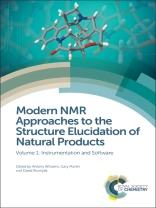Strychnine’s poisonous nature was known in 16th century Europe, and the alkaloid was isolated in pure form for the first time in 1818. Then began a more than century-long quest to unravel the structure of strychnine that led to two Nobel prizes, clearly without the assistance of the modern spectroscopic methods to which we now have access. In his 1963 report of the synthesis, Woodward said, ‘The tangled skein of atoms which constitutes its molecule provided a fascinating structural problem that was pursued intensively during the century just past, and was solved finally only within the last decade.’ The structure elucidation of complex natural products is facilitated today by access to modern instrumentation and experimental techniques. Using a modern 600 MHz NMR spectrometer equipped with a 1.7 mm cryogenic probe and a 1 mg sample, it is now possible to acquire a comprehensive suite of 2D NMR spectra that rigorously characterizes the complex structure of strychnine in a scant 24 hours. When the 2D NMR data are combined with Computer-Assisted Structure Elucidation methods, the structure can be solved in mere seconds. It is against this historical backdrop that these two volumes regarding the Structure Elucidation of Natural Products by NMR is set.
Volume 1 discusses contemporary NMR approaches including optimized and future hardware and experimental approaches to obtain both the highest quality and most appropriate spectral data for analysis. Volume 2 considers data processing and algorithmic based analyses tailored to natural product structure elucidation and reviews the application of NMR to the analysis of a series of different natural product families including marine natural products, terpenes, steroids, and carbohydrates. These books, bringing together acknowledged experts, uniquely focus on the combination of experimental approaches and modern hardware and software applied to the structure elucidation of natural products. The volumes will be an essential resource for NMR spectroscopists, natural product chemists and industrial researchers working on natural product analysis or the characterization of impurities and degradation products of pharmaceuticals that can be scarce as natural product samples.
Tabla de materias
An introduction to Modern NMR Spectroscopy for the Elucidation of Natural Products;NMR Magnets, a Historical Overview;Small volume NMR – Microprobes and Nanoprobes;Cryogenically Cooled NMR Probes: A Revolution for NMR Spectroscopy;Application of LC-NMR to the study of natural products;Application of non-uniform sampling for sensitivity enhancement of small molecule heteronuclear correlation NMR spectra;NMR Spectroscopy using Several Parallel Receivers;Dereplication using H1 NMR;Application of Computer Assisted Structure Elucidation;Multidimensional Spin Correlations by Covariance NMR;Future Approaches For Data Processing;Nutriceuticals;Molecular structure identification by atomic force microscopy
Sobre el autor
Antony J. Williams graduated with a BSc and Ph D in chemistry from the University of Liverpool and University of London respectively. He subsequently became a Post-doctoral Fellow at the National Research Council in Ottawa and then an NMR Facility Director at the University of Ottawa. He has also worked as an NMR Technology Leader at Eastman-Kodak Company in Rochester and held a number of positions, including Chief Science Officer, at ACD/Labs. In 2007, he established Chem Zoo, Inc and became host of Chem Spider, one of the primary internet portals for chemistry. Chem Spider was acquired by the Royal Society of Chemistry (RSC) in 2009 and Dr Williams is currently Vice-President of Strategic Development at the RSC. He presently holds an adjunct position at UNC-Chapel Hill and has been a member of the ACS since 1996. Gary E. Martin graduated with a BS in Pharmacy in 1972 from the University of Pittsburgh and a Ph D in Pharmaceutical Sciences from the University of Kentucky in 1975, specializing in NMR spectroscopy. He was a Professor at the University of Houston from 1975 to 1989, assuming the position of Section Head responsible for US NMR spectroscopy at Burroughs Wellcome, Co. in Research Triangle Park, NC, eventually being promoted to the level of Principal Scientist. In 1996 he assumed a position at what was initially the Upjohn Company in Kalamazoo, MI and held several positions there through 2006 by which time he was a Senior Fellow at what was then Pfizer, Inc. In 2006 he assumed a position as a Distinguished Fellow at Schering-Plough responsible for the creation of the Rapid Structure Characterization Laboratory. He is presently a Distinguished Fellow at Merck Research Laboratories. David Rovnyak earned his BS from the University of Richmond, and his Ph D studying high resolution NMR of quadrupolar nuclei at MIT. He transitioned to solution phase biomolecular NMR in postdoctoral work at the Harvard Medical School before joining the Chemistry Department at Bucknell University, where he has been recognized with Bucknell’s Excellence in Teaching Award. He currently serves as Assistant Editor of Concepts in Magnetic Resonance. His lab pursues interdisciplinary topics in biophysical research including bile acid aggregation, methods in protein NMR, nonuniform sampling and small molecule profiling.












